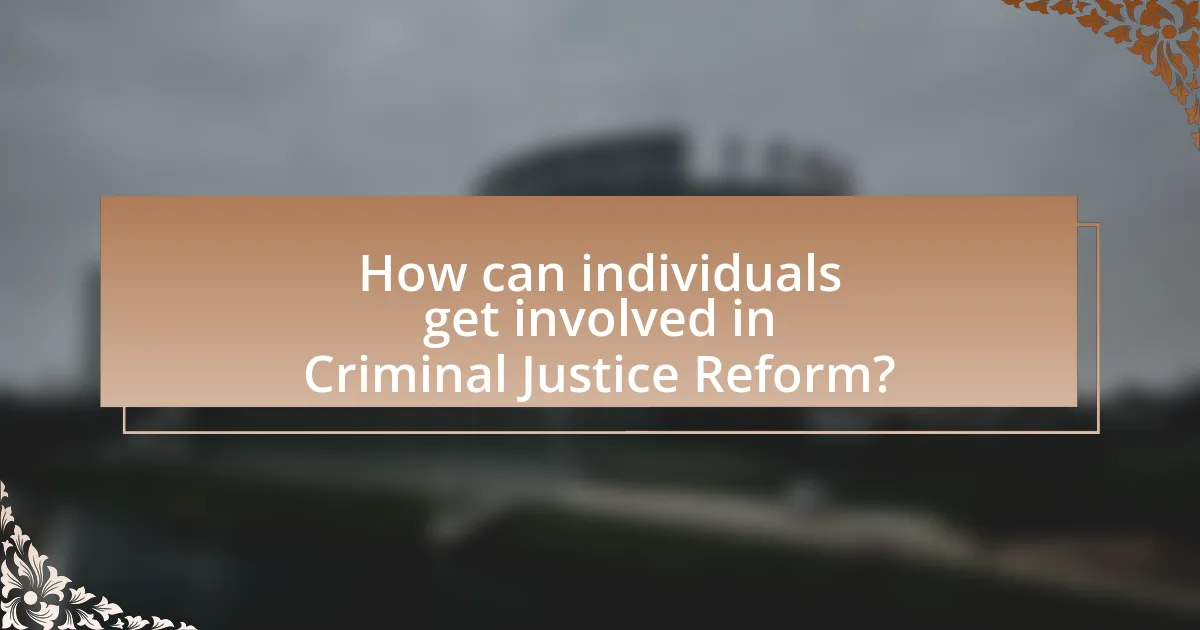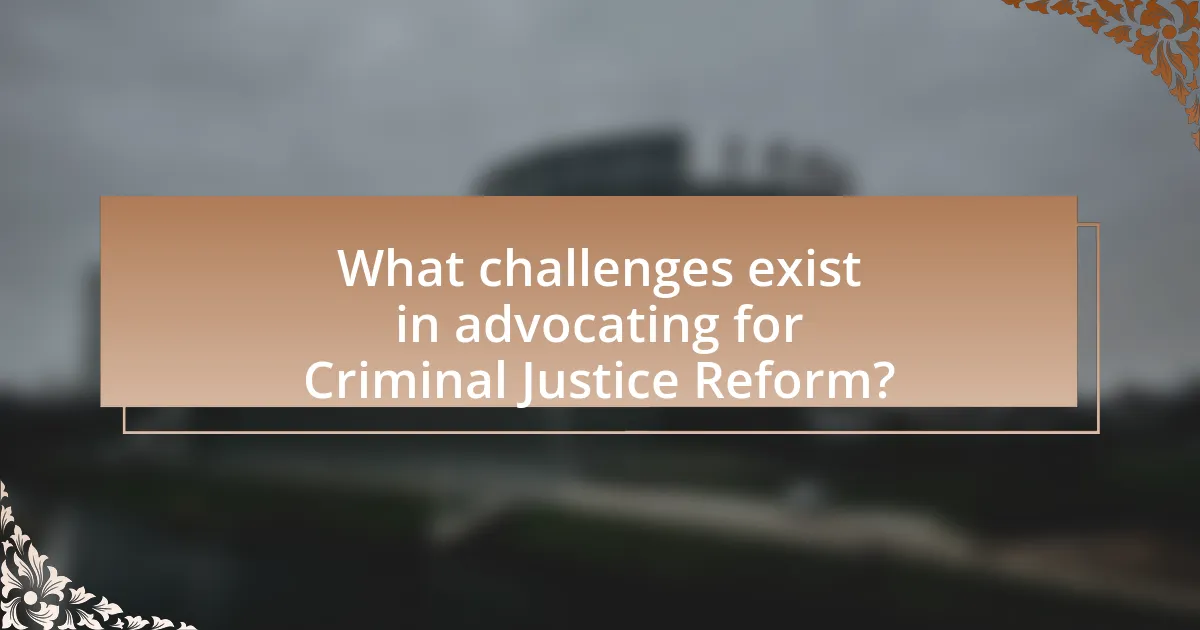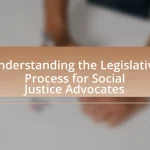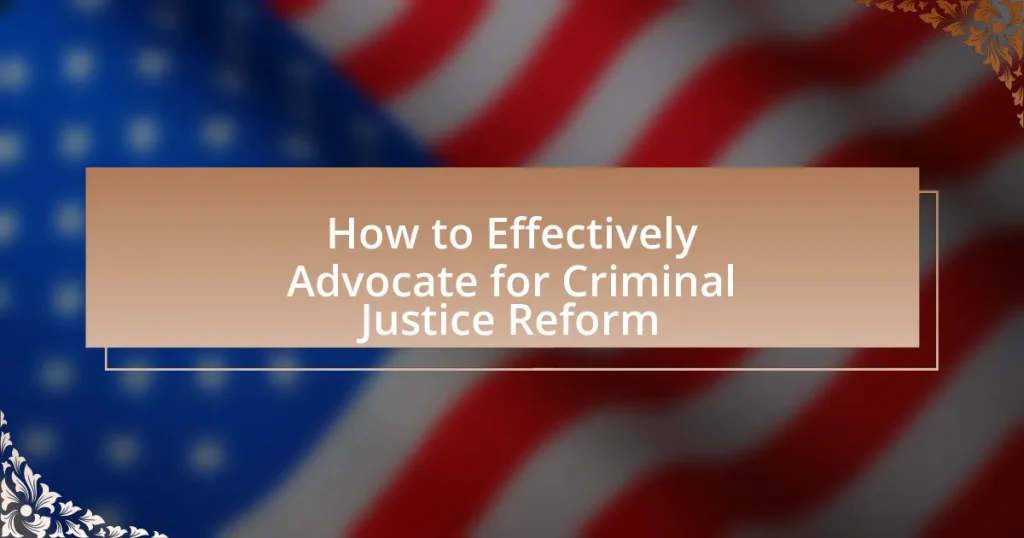Criminal Justice Reform Advocacy is the organized effort to change policies and practices within the criminal justice system to promote fairness and reduce systemic inequalities. This article outlines the importance of criminal justice reform, highlighting key issues such as racial bias, mass incarceration, and police accountability. It discusses the roles of various stakeholders, including policymakers and community organizations, in advocating for reform, as well as effective strategies for grassroots mobilization and public awareness. Additionally, the article addresses challenges faced by advocates and emphasizes the significance of continuous education and collaboration in driving meaningful change within the justice system.

What is Criminal Justice Reform Advocacy?
Criminal Justice Reform Advocacy is the organized effort to change policies, practices, and laws within the criminal justice system to promote fairness, reduce incarceration rates, and address systemic inequalities. This advocacy often focuses on issues such as sentencing reform, police accountability, and the decriminalization of certain offenses. For example, organizations like the American Civil Liberties Union (ACLU) and the Brennan Center for Justice actively work to influence legislation and public opinion, demonstrating the impact of advocacy through successful campaigns that have led to significant reforms in various states.
Why is Criminal Justice Reform Important?
Criminal justice reform is important because it addresses systemic issues such as racial bias, wrongful convictions, and excessive sentencing, which undermine the fairness and effectiveness of the justice system. For instance, studies show that Black Americans are incarcerated at more than five times the rate of white Americans, highlighting significant racial disparities that reform aims to rectify. Additionally, the Innocence Project reports that over 375 people in the U.S. have been exonerated after serving time for crimes they did not commit, emphasizing the need for reforms that prevent wrongful convictions and ensure accountability. By implementing reforms, society can create a more equitable and just legal system that upholds the rights of all individuals.
What are the key issues within the current criminal justice system?
The key issues within the current criminal justice system include systemic racism, mass incarceration, inadequate mental health resources, and lack of accountability for law enforcement. Systemic racism manifests in disproportionate arrest and sentencing rates for minority populations, with studies indicating that Black Americans are incarcerated at more than five times the rate of white Americans. Mass incarceration is driven by harsh sentencing laws and the war on drugs, resulting in the U.S. having the highest incarceration rate in the world, with over 2 million individuals behind bars. Inadequate mental health resources lead to a significant number of individuals with mental health issues being incarcerated instead of receiving appropriate treatment, contributing to a cycle of reoffending. Lastly, the lack of accountability for law enforcement is evident in the prevalence of police misconduct and the difficulty in prosecuting officers for abuses, undermining public trust in the justice system.
How does criminal justice reform impact communities?
Criminal justice reform positively impacts communities by reducing incarceration rates and promoting rehabilitation over punishment. Studies indicate that jurisdictions implementing reforms, such as diversion programs and restorative justice practices, experience lower crime rates and improved community relations. For example, the Vera Institute of Justice reported that cities adopting such reforms saw a 20% decrease in jail populations, leading to enhanced public safety and community trust in law enforcement. Additionally, reforms often address systemic inequalities, fostering a more equitable justice system that benefits marginalized populations.
Who are the key stakeholders in Criminal Justice Reform?
The key stakeholders in Criminal Justice Reform include government officials, law enforcement agencies, advocacy groups, community organizations, legal professionals, and affected individuals. Government officials, such as legislators and policymakers, play a crucial role in enacting reforms through legislation. Law enforcement agencies are involved in implementing changes and adapting practices. Advocacy groups, like the American Civil Liberties Union, work to raise awareness and push for specific reforms. Community organizations represent the interests of local populations and often provide support for those impacted by the justice system. Legal professionals, including attorneys and judges, influence reform through their interpretations of the law and courtroom practices. Affected individuals, including formerly incarcerated people and their families, provide firsthand accounts that highlight the need for reform and can drive public support.
What roles do policymakers play in advocating for reform?
Policymakers play a crucial role in advocating for reform by shaping legislation, mobilizing resources, and influencing public opinion. They draft, propose, and support laws that address issues within the criminal justice system, such as sentencing reform and police accountability. For instance, the passage of the First Step Act in 2018, which aimed to reduce recidivism and reform sentencing laws, exemplifies how policymakers can enact significant changes. Additionally, they engage with stakeholders, including community organizations and advocacy groups, to gather input and build coalitions that support reform initiatives. By leveraging their platforms, policymakers can raise awareness and drive public discourse around necessary changes, ultimately facilitating a more effective and equitable criminal justice system.
How can community organizations contribute to advocacy efforts?
Community organizations can significantly contribute to advocacy efforts by mobilizing grassroots support, raising awareness, and providing resources for policy change. These organizations often have established relationships within their communities, enabling them to effectively engage residents and gather diverse perspectives on criminal justice issues. For instance, organizations like the American Civil Liberties Union (ACLU) have successfully mobilized community members to advocate for reforms such as the reduction of mandatory minimum sentences, demonstrating the power of collective action. Additionally, community organizations can conduct research and disseminate information that highlights systemic injustices, thereby influencing public opinion and policymakers. Their ability to organize events, workshops, and campaigns further amplifies their impact, as seen in initiatives that have led to significant legislative changes in various states.
What strategies can be employed for effective advocacy?
Effective advocacy for criminal justice reform can be achieved through strategies such as building coalitions, utilizing data-driven arguments, and engaging in grassroots mobilization. Building coalitions involves collaborating with diverse stakeholders, including community organizations, legal experts, and affected individuals, to create a unified front that amplifies the advocacy message. Data-driven arguments are essential, as they provide empirical evidence to support claims, making the case for reform more compelling; for instance, studies have shown that states implementing criminal justice reforms have seen reductions in incarceration rates and recidivism. Grassroots mobilization empowers communities to participate actively in advocacy efforts, fostering a sense of ownership and urgency around reform issues. These strategies collectively enhance the effectiveness of advocacy initiatives in driving meaningful change in the criminal justice system.
How can grassroots movements influence criminal justice reform?
Grassroots movements can influence criminal justice reform by mobilizing community support, raising awareness about injustices, and advocating for policy changes. These movements often highlight systemic issues, such as racial disparities and police brutality, which can lead to public outcry and demand for legislative action. For instance, the Black Lives Matter movement has significantly impacted discussions around police reform and accountability, leading to policy changes in various jurisdictions. Research indicates that grassroots advocacy can result in tangible reforms, as seen in the passage of laws aimed at reducing mass incarceration and enhancing community policing practices.
What role does public awareness play in advocacy efforts?
Public awareness is crucial in advocacy efforts as it mobilizes support and influences policy change. When the public is informed about issues, such as those in criminal justice reform, they are more likely to engage, advocate, and apply pressure on decision-makers. For instance, campaigns that raise awareness about wrongful convictions have led to legislative changes in several states, demonstrating that informed citizens can drive significant reform. Studies show that increased public awareness correlates with higher levels of civic engagement, which is essential for effective advocacy.

How can individuals get involved in Criminal Justice Reform?
Individuals can get involved in Criminal Justice Reform by participating in advocacy groups, attending community meetings, and engaging in public policy discussions. Advocacy groups such as the American Civil Liberties Union (ACLU) and the Brennan Center for Justice actively work on reform initiatives and welcome volunteers. Community meetings often provide platforms for citizens to voice concerns and propose changes, fostering local engagement. Additionally, individuals can influence public policy by contacting elected officials, signing petitions, and participating in campaigns that promote legislative changes aimed at reforming the criminal justice system. According to a 2020 report by the Vera Institute of Justice, grassroots movements have significantly impacted policy changes in various states, demonstrating the effectiveness of individual involvement in reform efforts.
What are the various ways to advocate for reform?
Advocating for reform can be achieved through various methods, including grassroots organizing, lobbying, public awareness campaigns, and coalition building. Grassroots organizing involves mobilizing community members to participate in advocacy efforts, which can lead to significant local impact. Lobbying entails engaging with lawmakers to influence policy decisions directly, often through meetings, testimonies, or providing research data. Public awareness campaigns utilize media and social platforms to educate the public about reform issues, aiming to shift public opinion and garner support. Coalition building brings together diverse groups to strengthen advocacy efforts, pooling resources and expertise to create a unified front for reform initiatives. These methods have been effective in various reform movements, such as the push for criminal justice reform, where organizations like the American Civil Liberties Union have successfully utilized these strategies to influence legislation and public policy.
How can social media be utilized for advocacy?
Social media can be utilized for advocacy by amplifying messages, mobilizing supporters, and fostering community engagement. Platforms like Twitter, Facebook, and Instagram allow advocates to share information, raise awareness about criminal justice issues, and connect with a broader audience. For instance, campaigns such as #BlackLivesMatter have effectively used social media to highlight systemic injustices and mobilize protests, demonstrating the power of these platforms in driving social change. Additionally, studies show that social media can increase public engagement and participation in advocacy efforts, as seen in the rise of online petitions and grassroots movements that gain traction through viral sharing.
What are the benefits of joining advocacy groups?
Joining advocacy groups provides individuals with a platform to amplify their voices and influence policy changes effectively. These groups often have established networks and resources that facilitate collective action, enabling members to engage in lobbying efforts, raise public awareness, and mobilize community support for criminal justice reform. For instance, organizations like the American Civil Liberties Union (ACLU) have successfully advocated for legislative changes that protect civil rights, demonstrating the tangible impact advocacy groups can have on shaping laws and policies.
How can one effectively communicate the need for reform?
To effectively communicate the need for reform, one should present clear, data-driven arguments that highlight the shortcomings of the current system. For instance, statistics indicating high recidivism rates, such as the Bureau of Justice Statistics reporting that about 68% of released prisoners are arrested within three years, can illustrate the urgency for change. Additionally, using personal stories from affected individuals can humanize the issue and create emotional resonance, making the case for reform more compelling. Engaging stakeholders through community forums and leveraging social media platforms can further amplify the message, ensuring it reaches a broader audience and fosters public support for necessary changes in the criminal justice system.
What messaging strategies resonate with the public?
Messaging strategies that resonate with the public include using relatable narratives, emphasizing shared values, and presenting clear, actionable solutions. Relatable narratives create emotional connections, making complex issues more understandable and personal. For instance, storytelling about individuals affected by criminal justice policies can humanize statistics and foster empathy. Emphasizing shared values, such as fairness and justice, aligns the message with the audience’s beliefs, increasing engagement. Presenting clear, actionable solutions empowers the public by showing them how they can contribute to change, which is supported by research indicating that people are more likely to support initiatives when they understand specific actions they can take (Pew Research Center, 2021).
How can personal stories enhance advocacy efforts?
Personal stories enhance advocacy efforts by creating emotional connections that resonate with audiences, making complex issues more relatable. When individuals share their experiences, they humanize abstract concepts, allowing listeners to empathize and understand the real-life implications of policies or injustices. Research indicates that narratives can significantly influence public opinion; for instance, a study published in the journal “Science” found that personal stories can increase support for social issues by up to 20%. This emotional engagement can mobilize communities, inspire action, and ultimately drive policy change in criminal justice reform.

What challenges exist in advocating for Criminal Justice Reform?
Advocating for Criminal Justice Reform faces several challenges, including political resistance, public perception, and systemic inertia. Political resistance often arises from lawmakers who may fear backlash from constituents or who have vested interests in maintaining the status quo, as seen in various states where reform proposals have stalled despite public support. Public perception can hinder reform efforts, as misinformation and fear surrounding crime can lead to opposition against changes perceived as lenient. Systemic inertia is evident in entrenched practices and policies within law enforcement and judicial systems, making it difficult to implement new approaches. These challenges collectively impede progress toward meaningful reform in the criminal justice system.
What are the common obstacles faced by advocates?
Advocates commonly face obstacles such as limited funding, lack of public awareness, and resistance from established institutions. Limited funding restricts the resources available for outreach and advocacy efforts, making it difficult to sustain campaigns. Lack of public awareness can hinder support for reform initiatives, as many individuals may not understand the issues at stake. Additionally, resistance from established institutions, including law enforcement and political entities, can create significant barriers to implementing changes in the criminal justice system. These challenges are documented in various studies, including the “Challenges in Criminal Justice Advocacy” report by the National Criminal Justice Association, which highlights the systemic issues advocates encounter in their efforts for reform.
How can misinformation hinder advocacy efforts?
Misinformation can significantly hinder advocacy efforts by undermining credibility and distorting public perception. When advocates rely on inaccurate information, it can lead to misguided strategies and weaken their arguments, making it difficult to gain support from stakeholders. For instance, a study by the Pew Research Center found that 64% of Americans believe misinformation has a major impact on public opinion, which can directly affect the effectiveness of advocacy campaigns. This distortion can create confusion among the public and policymakers, ultimately obstructing meaningful dialogue and progress in criminal justice reform initiatives.
What strategies can be used to overcome resistance to change?
To overcome resistance to change, effective strategies include clear communication, stakeholder involvement, and providing training. Clear communication ensures that all parties understand the reasons for the change and its benefits, which can reduce anxiety and uncertainty. Involving stakeholders in the change process fosters a sense of ownership and commitment, making them more likely to support the initiative. Providing training equips individuals with the necessary skills and knowledge to adapt to the change, further alleviating resistance. Research indicates that organizations that implement these strategies experience higher rates of successful change adoption, as evidenced by a study published in the Journal of Organizational Change Management, which found that effective communication and stakeholder engagement significantly correlate with positive change outcomes.
How can advocates measure the impact of their efforts?
Advocates can measure the impact of their efforts through quantitative and qualitative assessments, including tracking changes in legislation, public opinion, and community engagement. For instance, analyzing the number of bills passed or amended as a direct result of advocacy efforts provides concrete evidence of legislative impact. Additionally, surveys and interviews can gauge shifts in public awareness and attitudes towards criminal justice issues, demonstrating the effectiveness of advocacy campaigns. Research by the Urban Institute indicates that successful advocacy can lead to significant policy changes, highlighting the importance of measurable outcomes in evaluating impact.
What metrics can be used to assess advocacy success?
Metrics used to assess advocacy success include policy changes, public awareness levels, stakeholder engagement, and funding increases. Policy changes can be measured by the number of laws or regulations enacted as a result of advocacy efforts, indicating direct influence on the legislative process. Public awareness levels can be assessed through surveys measuring knowledge and attitudes about criminal justice reform among the general population. Stakeholder engagement can be evaluated by tracking participation rates in advocacy events and the diversity of coalitions formed, reflecting the breadth of support for reform initiatives. Funding increases can be quantified by analyzing financial contributions to advocacy organizations, which often correlate with perceived effectiveness and impact.
How can feedback from the community inform future advocacy?
Feedback from the community can significantly inform future advocacy by providing insights into the needs and concerns of those directly affected by criminal justice policies. Engaging with community members allows advocates to identify specific issues, such as racial disparities or access to legal resources, that require attention. For instance, a study by the Vera Institute of Justice found that community input led to more effective policy changes in local jurisdictions, demonstrating that advocacy efforts aligned with community priorities are more likely to succeed. By incorporating this feedback, advocates can tailor their strategies to address real-world challenges, ensuring that reforms are relevant and impactful.
What are the best practices for successful advocacy in Criminal Justice Reform?
The best practices for successful advocacy in Criminal Justice Reform include building coalitions, utilizing data-driven strategies, and engaging with affected communities. Building coalitions allows diverse stakeholders to unite, amplifying voices and resources, which has been shown to enhance advocacy efforts significantly. Utilizing data-driven strategies involves collecting and analyzing relevant statistics to support reform proposals, as evidenced by studies indicating that data-backed arguments are more persuasive to policymakers. Engaging with affected communities ensures that advocacy efforts are grounded in real experiences, fostering authenticity and trust, which is crucial for effective reform initiatives.
How can collaboration enhance advocacy efforts?
Collaboration can enhance advocacy efforts by pooling resources, expertise, and networks to create a more unified and powerful voice for change. When organizations and individuals work together, they can leverage diverse perspectives and skills, which increases the effectiveness of their campaigns. For instance, a study by the National Council of Nonprofits found that collaborative advocacy efforts can lead to a 30% increase in policy influence compared to isolated initiatives. This collective approach not only amplifies messaging but also fosters greater community engagement and support, ultimately driving more significant reforms in criminal justice.
What role does continuous education play in effective advocacy?
Continuous education is essential for effective advocacy as it equips advocates with up-to-date knowledge and skills necessary to address complex issues. In the context of criminal justice reform, continuous education enables advocates to understand evolving laws, policies, and social dynamics, which enhances their ability to influence change. For instance, a study by the National Institute of Justice highlights that informed advocates are more successful in mobilizing community support and engaging policymakers, demonstrating that ongoing learning directly correlates with advocacy effectiveness.










